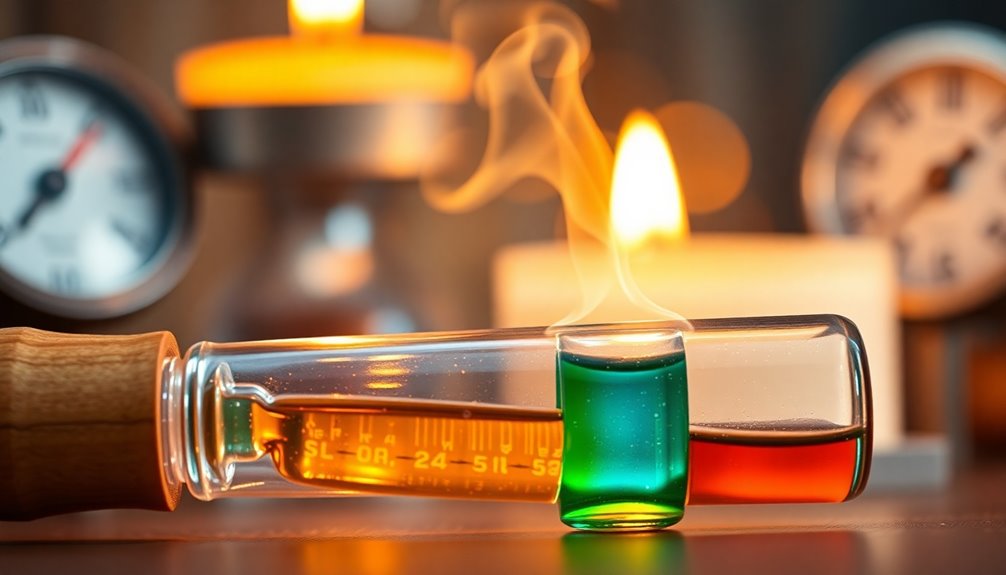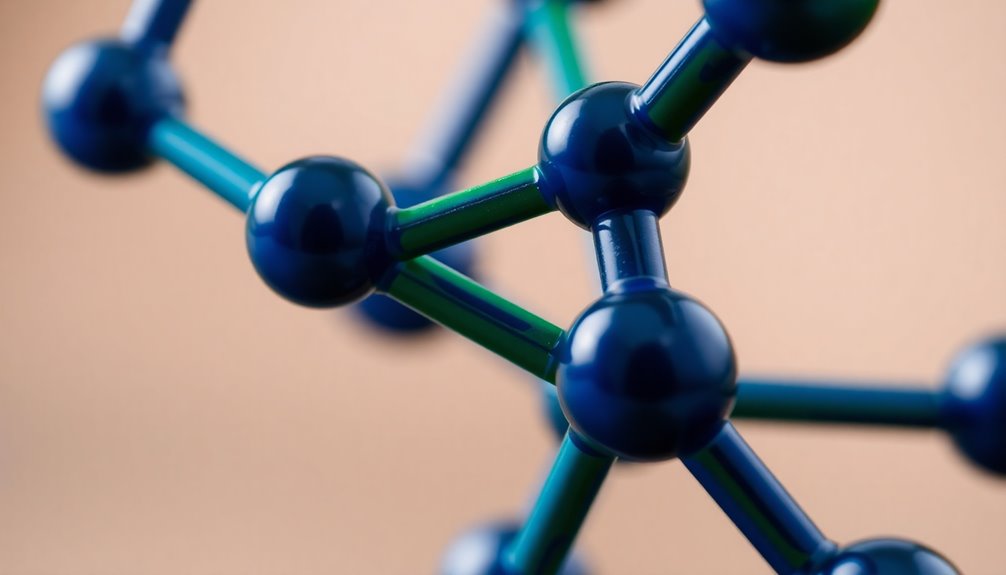Aromatic overtones are weak signals in the infrared spectrum, vital for understanding the vibrational properties of aromatic compounds. When molecules shift from a lower to a higher vibrational state, you can detect these subtle shifts, usually occurring below 2200 cm⁻¹. They're often 10-100 times less intense than fundamental vibrations. Factors like molecular alignment and symmetry affect their visibility. While these overtones provide significant information for spectroscopic analysis, challenges like temperature effects can complicate detection. Discover how these characteristics and challenges play a role in chemical analysis as you explore further.
Key Takeaways
- Aromatic overtones are higher vibrational transitions in aromatic compounds detected using infrared spectroscopy.
- They occur when molecules shift from ground vibrational states to excited states, typically producing weaker signals than fundamental vibrations.
- Overtone shifts are usually found below 2200 cm⁻¹ and can be influenced by molecular alignment, symmetry, and dipole direction.
- Combination bands arise from simultaneous excitation of multiple vibrational modes, contributing additional spectral features.
- Temperature affects overtone detection, with higher temperatures leading to hot bands which complicate spectral analysis.
Understanding Aromatic Overtones

Aromatic overtones play an essential role in understanding the vibrational characteristics of aromatic compounds. When you analyze compounds like benzene using infrared spectroscopy, you'll notice shifts from the ground vibrational state to higher states.
These aromatic overtones typically appear as weaker peaks, about 10-100 times less intense than fundamental vibrations, in the infrared spectrum below 2200 cm⁻¹. Their visibility is influenced by factors such as molecular alignment and dipole direction.
Additionally, combination bands can contribute to these weak shifts, especially in the near-IR region. Keep in mind that temperature impacts these overtone shifts; higher temperatures increase hot bands, while cooler conditions enhance the clarity of fundamental lines.
Understanding these aspects is essential for interpreting spectral data effectively.
Mechanism of Overtone Transitions

When you explore the mechanism of overtone shifts, you'll notice how molecules move from lower to higher vibrational energy levels.
These shifts rely heavily on selection rules, which determine how likely these energy changes are to occur based on molecular alignment.
Understanding these principles helps clarify why overtone bands are generally weaker and less populated than fundamental shifts.
Energy Level Transitions
Overtone changes play a crucial role in understanding molecular vibrations, as they occur when a molecule shifts from its ground vibrational state (v=0) to higher excited states (v=2, v=3, etc.).
These overtone shifts generally produce weaker absorption peaks, being 10-100 times less intense than fundamental transitions. This reduced intensity happens because fewer molecules occupy excited states at thermal equilibrium.
The quantized energy levels involved in overtone shifts reflect specific molecular vibrations and structures. Additionally, combination bands can emerge when multiple vibrational modes are excited simultaneously, adding further weak peaks to the infrared spectrum.
Although any fundamental vibrational mode can lead to overtone shifts, those with lower energy are more likely to participate.
Selection Rules Impact
Understanding the selection rules that dictate overtone changes is essential for interpreting molecular vibrations in spectroscopy. Overtone shifts occur when a molecule absorbs energy, moving from the ground state to higher vibrational states, often with Δv values of 2 or more.
However, the selection rules highlight that these shifts are less likely than fundamental ones, which typically involve Δv = 1. As a result, overtone shifts exhibit weaker absorption peaks, often 10-100 times less intense due to lower excited state populations.
Additionally, factors like molecular alignment and temperature can influence these shifts' intensity and visibility. Higher temperatures may enhance overtone shifts through hot bands, further demonstrating how selection rules impact the behavior of molecular vibrations in spectroscopy.
Spectral Characteristics and Regions

Aromatic overtones, which manifest in the infrared (IR) spectrum below 2200 cm⁻¹, reveal key insights into molecular vibrations. These shifts, moving from the ground vibrational state to higher energy states, are typically much weaker than fundamental vibrations, often 10-100 times less intense. This makes them less prominent in spectral analysis, but they play an essential role.
- Combination bands arise from simultaneous excitation of multiple vibrational modes.
- Molecular alignment and dipole moments influence the visibility of overtone shifts.
- Understanding aromatic overtones aids in accurate vibrational spectroscopy interpretation.
- Recognizing the spectral regions helps you distinguish between overtone and fundamental signals.
Grasping these characteristics is significant for effective analysis of aromatic compounds in the infrared spectrum.
Influence of Temperature on Overtone

When you increase the temperature of a sample, you'll notice a shift in vibrational states that can enhance overtone changes.
This phenomenon leads to the appearance of hot bands, making it essential to control the temperature during spectroscopic experiments.
Temperature and Vibrational States
Temperature plays an essential role in influencing vibrational states and overtone shifts in molecules. In IR Spectroscopy, as temperature increases, more molecules occupy excited vibrational states, which can modify overtone changes.
Here's how temperature impacts these dynamics:
- Higher temperatures lead to a broader range of overtone changes becoming observable.
- Ground state transitions dominate at lower temperatures due to a higher population in the v = 0 state.
- Cooling samples can enhance the clarity of fundamental lines by minimizing contributions from hot bands.
- Controlling thermal conditions is vital for accurate spectroscopic analyses, as temperature variations can greatly affect change intensities.
Understanding these relationships helps you optimize your experiments and interpret results more effectively.
Hot Bands Phenomenon
As thermal energy increases, higher vibrational states become more populated, leading to the emergence of hot bands in infrared spectra.
When you raise the temperature, the likelihood of these hot bands appearing increases, as shifts to higher vibrational states (v=1 and above) become more probable.
This can greatly impact the intensity of overtone transitions, complicating your spectral analysis. You may notice additional peaks overlapping with fundamental transitions, making interpretation more challenging.
The presence of hot bands emphasizes how temperature affects molecular vibrational states and the resulting spectral features.
Understanding this phenomenon is essential for accurate infrared spectroscopy, helping you navigate the complexities of spectral data more effectively.
Cooling Sample Effects
By cooling samples, you can greatly enhance the clarity of overtone shifts in infrared spectroscopy. Lower temperatures reduce the intensity of overtone changes, as fewer higher vibrational states populate. This leads to clearer fundamental lines in IR spectra, making the analysis of combination bands much more straightforward.
- Ground state changes dominate, enhancing fundamental peaks.
- Weaker overtone bands result in clearer spectral analysis.
- Cooler samples minimize complications from hot bands.
- Enhanced resolution helps in accurate identification of features.
Utilizing cooling sample effects not only improves the quality of your spectral data but also allows for more precise interpretations of aromatic compounds, ultimately leading to better insights in your research.
Applications in Vibrational Spectroscopy

Aromatic overtones play a significant role in vibrational spectroscopy, particularly in analyzing complex molecular structures. You'll find these shifts occur at higher multiples of fundamental vibrational frequencies, often appearing below the 2200 cm⁻¹ region in IR spectra.
Although they're typically 10-100 times weaker than fundamental bands, aromatic overtones provide vital structural insights into aromatic compounds, especially substituted benzenes. By evaluating overtone and combination bands, you can distinguish unique spectral fingerprints that reveal molecular alignment and dipole direction.
These factors influence the intensity and visibility of spectral lines, making it essential to understand the selection rules governing overtone shifts. This knowledge enhances your ability to interpret vibrational spectra effectively and accurately.
Comparison With Fundamental Vibrations

While analyzing vibrational spectra, you'll notice that aromatic overtones differ considerably from fundamental vibrations. Aromatic overtones represent changes from the ground vibrational state to higher states, typically being 10-100 times weaker than the intense peaks of fundamental vibrations.
You'll find that:
- Fundamental vibrations show strong IR signals.
- Overtone changes appear at higher frequencies with lower intensities.
- The molecule's symmetry and dipole moment affect overtone intensity.
- Combination bands, which involve multiple vibrations, are also weaker than fundamental changes.
Understanding these differences is essential for interpreting vibrational spectra accurately.
Challenges in Overtone Analysis

Detecting and analyzing overtone changes in spectroscopy presents several challenges due to their inherent weakness, often being 10-100 times less intense than fundamental changes.
When you're working with overtone shifts, you'll find that molecular alignment and dipole moment direction can greatly impact your results, complicating spectral data interpretation.
Additionally, selection rules can restrict the visibility of these shifts, making it hard to detect them in certain molecular configurations or vibrational modes.
High temperatures may introduce hot bands, further muddling your analysis by adding extra shifts.
While polarization spectroscopy techniques can enhance the visibility of overtone shifts, you need to guarantee effective sample alignment to achieve meaningful reductions in overtone signal intensity.
Future Directions in Research

As researchers explore deeper into the nuances of overtone analysis, they're likely to focus on enhancing sensitivity and resolution in spectroscopic techniques.
This progress could greatly improve detection limits in chemical analysis, leading to more precise results.
Here are some future directions you might find interesting:
- Utilizing machine learning algorithms to interpret overtone spectra
- Investigating molecular alignment and dipole orientation's impact on overtone visibility
- Studying temperature effects on overtone shifts to minimize hot band effects
- Expanding research on overtone and combination bands in aromatic derivatives
Frequently Asked Questions
What Is an Overtone in Organic Chemistry?
An overtone in organic chemistry is a vibrational shift that occurs at multiples of the fundamental frequency.
When you analyze molecular vibrations, you'll notice that these shifts, like from the ground state to higher states, are generally weaker.
They're less pronounced in infrared spectra, but they can reveal important structural characteristics of compounds.
Understanding overtone shifts can help you gain deeper insights into the behavior of complex organic molecules you're studying.
What Does Aromatic Mean in Chemistry?
Imagine a well-structured song where each note harmonizes perfectly. In chemistry, "aromatic" refers to compounds with a stable ring structure, like benzene, that resonate similarly.
These compounds boast unique properties, such as high stability and specific reactivity, thanks to their alternating single and double bonds.
Just like a catchy melody, aromatic compounds engage in reactions, making them essential in organic chemistry and various industrial applications.
What Is the Aromatic Region of NMR?
The aromatic region of NMR refers to the chemical shift range of 6.5 to 8 ppm, where protons on aromatic rings resonate due to delocalized electrons.
You'll notice that substituents affect these shifts; electron-donating groups pull signals upfield, while electron-withdrawing groups push them downfield.
Additionally, you can determine the number of equivalent aromatic protons through integration ratios, helping you elucidate the compound's structure and understand its behavior in the spectrum.
What Causes Overtones in IR Spectroscopy?
Overtones in IR spectroscopy arise when molecules shift between vibrational energy levels, typically from the ground state to higher levels.
You'll notice that these overtone shifts are weaker than fundamental shifts, often 10-100 times less intense. Factors like molecular alignment and dipole direction influence their presence and intensity.
Additionally, higher temperatures can lead to hot bands, where overtone shifts start from already excited vibrational states, enhancing the spectrum's complexity.
Conclusion
In summary, understanding aromatic overtones enhances your grasp of molecular vibrations and their applications in vibrational spectroscopy. While some might argue that overtone analysis is complex, visualizing these concepts through diagrams or spectral graphs can simplify them. By illustrating the relationship between overtone shifts and their spectral characteristics, you'll see how this knowledge can lead to innovative applications in chemistry and materials science. Embracing these insights opens doors to exciting research opportunities in the field.










